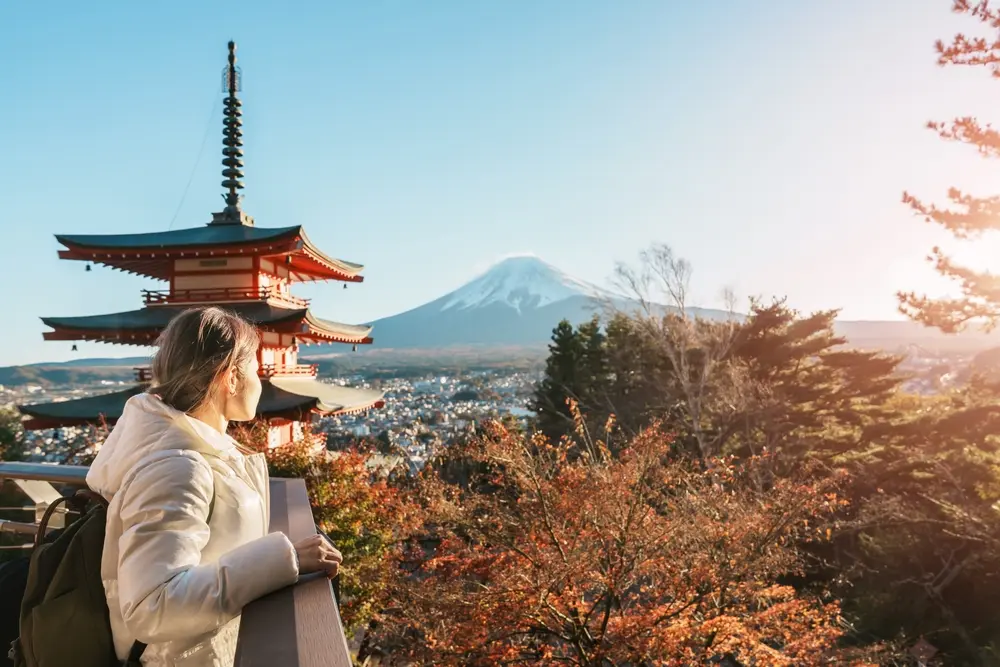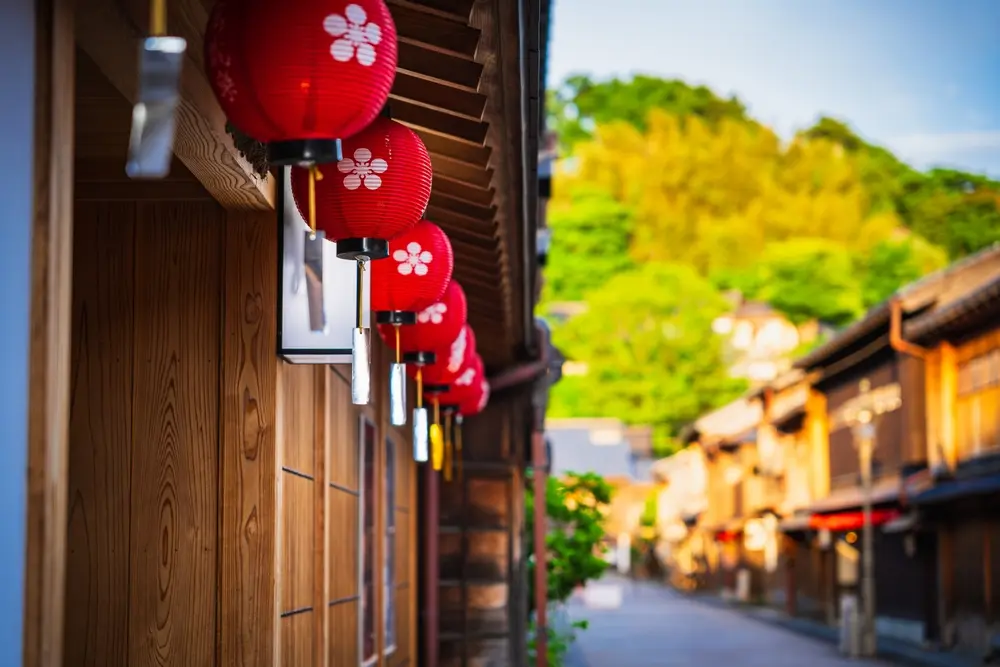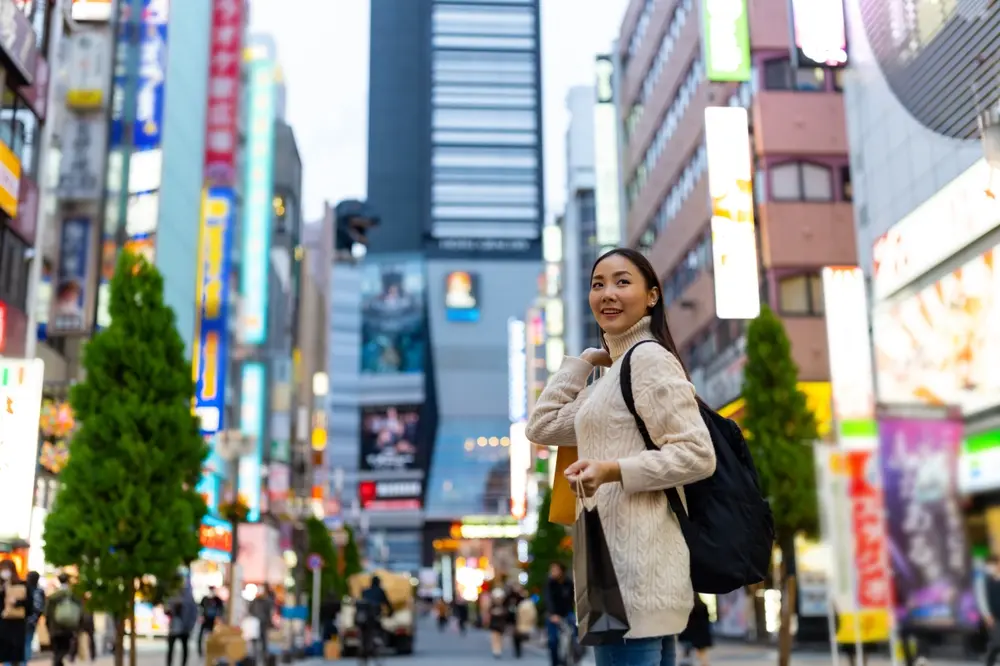Breathe the air at the top of Mount Fuji. Taste the street food in Osaka. Smell the cherry blossoms in Kansai.
How you spend your time in Japan is up to you. Whatever your dream trip looks like, travel insurance is important. Whether you need cover for pre-existing medical conditions or cover for more strenuous activities.
The appetite for solo travelling is increasing post-pandemic, especially for travellers from the UK. And with Japan being one of the safest destinations in the world, more solo travellers are adding it to their dream destination lists. Around 30 million people visited in 2024 and its cities regularly top Lonely Planet’s lists, with the Best in Travel 2025 list being no exception.
Is it safe to travel alone in Japan?

Japan has a low crime rate, but as with any solo travel, you should be careful. For solo travellers anywhere, there are risks when you’re in unfamiliar places. Check the government’s website for up-to-date safety information when travelling to Japan.
- Pickpocketing and bag snatching happen in busy areas.
- Be wary of scams that target tourists, such as overpriced goods or people approaching appearing to be in distress and asking for money.
- Some people have reported waking up with no memory of their night but with huge credit card charges – it’s possible their drinks were spiked and their cards were used when they were incapacitated.
- The situation in nearby Korea can be tense and can change quickly. Always check the Foreign Office’s advice before travelling.
If you do need help while travelling solo in Japan, call 110 for the police.
Top tips for travelling safely alone in Japan
- Accommodation: There are so many different options. Capsule hotels are incredibly popular amongst travellers and are even becoming a ‘thing to do’ in Japan in their own right. You can find luxury to budget options and single-sex floors in some capsule hotels, making them ideal choices for travellers of varying budgets or those travelling alone. They’re often located near train stations so are perfect for connecting trains or for stays before a day trip to another city or island. HostelWorld has 306 hostels in 67 cities in Japan, and hostels are often a great way to meet other solo travellers. They’re usually designed with communal spaces to encourage connections and friendships.
- Paying for things: Cash is still very much an accepted currency in Japan. Especially for entry at tourist attractions, or in small cafes and shops, cash is appreciated. Although many places now accept debit/credit cards and some places accept Apple pay, smaller towns and villages do not.
- Travelling around: Many people speak English and at the main stations there’s often an English translation on the signs. It can help to have important addresses written in Japanese – your hotel, where you’re going etc. – so you can pass it to taxi drivers or show it to someone if you’re lost.
- In an emergency: save emergency numbers in your phone, but also have them written down in case your phone is lost or stolen. Write the contact number for the British embassy, your hotel, your insurer and the emergency services somewhere safe.
- An itinerary: Whilst it’s fun to be spontaneous, it’s a good idea that someone knows where you are and where you’re supposed to be. Share your location with someone – a family member or friend – even if they’re abroad. It will help locate you in an emergency. If you’re going anywhere, you can let staff at your hotel or hostel know when you expect to be back.
Common risks in Japan
Laws and customs can differ to the UK. Some of the most common differences include:
- You must carry ID with you at all times when travelling in Japan. The police can arrest you if you can’t produce it.
- In some cities, smoking is illegal in the streets. You can only smoke in designated smoking areas.
- The penalty for drug crime is severe, with British nationals facing prison sentences and fines. Drug testing can be carried out during drug raids on clubs and bars and if you test positive the consequences can be severe.
- Under Japan’s strict drugs policy, some over-the-counter or commonly prescribed drugs in the UK can be banned. Ignorance of the law is not considered an excuse.
Extreme weather events in Japan
Earthquakes, typhoons and tsunamis are increasing in frequency. It’s worth signing up to weather and earthquake updates for the areas you’ll be travelling in, especially if they’re in frequently hit areas or if you’ll be visiting islands or the coast.
Your travel insurer will often be able to help if you need to cut your trip short because of an extreme weather event, or if you even have to cancel (if you have cancellation cover).
Regional risks in Japan

The FCDO updates their advice on regional risks regularly. Always check it before you travel, especially following extreme weather events.
Fukushima
There is a restricted area around the Fukushima Daiichi nuclear power plant where only authorised persons can enter. Areas where evacuation orders are ready to be lifted are still subject to some restrictions – for example, visitors are not allowed to stay overnight.
Noto Peninsula
Earthquakes hit the peninsula in January, causing a minor tsunami and fires in parts of the Ishikawa Prefecture. There can still be some disruption on transport in the area.
5 of the best places to visit in Japan as a solo traveller
Osaka
On Lonely Planet’s cities to visit for 2025, Osaka has a lot to offer solo travellers. Japan’s second largest city is safe, easy to travel around and has a plethora of culinary delights to enjoy.
- Visit the Shitenno-ji Temple, one of Japan’s oldest. The outer temple grounds are free, but there is a fee if you want to visit the inner precinct, the Gokuraku-jodo Garden or the treasure house. You can climb the five-storied pagoda, see paintings, scripture and other valuables dating back centuries, or just enjoy the peaceful tranquillity of the gardens.
- Dotonbori is a must-visit for foodies: it has so many different foods packed in along its main street, with many side streets branching off also offering culinary delights. Japanese food – including takoyaki (grilled octopus) and okonomiyaki (a pancake-like dish that in Osaka includes shredded cabbage, squid, prawn or octopus, and flour-based batter).
- Universal Studios Japan is in Osaka. It’s a huge tourist draw, so if you’re staying nearby you’ll undoubtedly meet other travellers with it on their agenda. Other major tourist draws include the science museum and aquarium.
- Visit Osaka Castle. It’s survived armies, lightning and fire, and this version has been standing since 1931. You’ll also find around 600 cherry trees surrounding the castle park, so it really is one of the most beautiful spots to enjoy.
Hiroshima
Now known as the International City of Peace and Culture, visitors from all over the world visit to pay their respects following the WW2 tragedy and to learn more about what happened.
- Peace Memorial Park contains a museum and memorial dome at the site where the bomb was dropped.
- Hiroshima castle was devastated by the bomb, but it has been rebuilt. The current structure is incredibly beautiful and is surrounded by 350 cherry trees.
- There is more to Hiroshima than its painful past. The nightlife in Hiroshima is rich and varied. Sake is world-class in the region and they take it very seriously – so much so that there’s a sake festival every year in October. Karaoke bars are also a fun way to start – or end! – a night, with cocktails, sake and more on tap if you need a little encouragement.
- Miyajima Island is a short 45 minutes from Miyajimaguchi pier, so it’s a great day trip from Hiroshima. You can see shrines, temples and other beautiful sites such as Mount Misen.
Tokyo
Japan’s largest city is also the largest city in the world. Home to just over 14 million people, Tokyo is also one of the safest cities you can find – making it an incredibly attractive destination of choice for solo travellers who want to kick off their Japan itinerary.
- The tallest tower in the world is the Tokyo Skytree. With panoramic views, there’s a whole host of things to do above the city on the observation deck: there’s a bar, sumo shows, yoga classes and events. You can even enjoy seeing it from the ground – there are special light shows they put on.
- Immerse yourself in Akihabara’s pop culture. The neon bright lights from the retro arcade games are dazzling, and there’s shop after shop of old video games treasures and manga comic shops.
- If you’re a seafood fan, you’ll find plenty to devour at Tokyo’s fish markets. Toyosu is the largest seafood market in the world, with early morning auctions and ready-to-eat delicacies that explode your mouth with flavour.
- And it’s not all just go, go, go. Tokyo can also be peaceful, a place for solo travellers to enjoy their freedom and solitude. There are hidden gems in the city for book lovers – from plenty of cafe- and bar-library hybrids to Inokashira Park.
You can meet people in so many ways in Tokyo:
- Do a group tour. You’ll find plenty of other solo travellers and couples, most of whom are more than happy to talk and buddy up.
- Do a group activity – from cooking classes to exercise classes such as yoga and spin.
- Stay in one of Tokyo’s hostels – there’s so many to choose from and they have a vibrant and friendly backpacking scene.
Fukuoka
Another one for foodies, Fukuoka is a vibrant, welcoming city with plenty to offer all travellers, but especially solo ones. It also has a rich history – given its proximity to the Asian mainland, it was chosen as the landing point for the Mongol invaders in the 13th century.
- You can join a nightly dinner party to meet people and socialise over street food. The yatai food stalls provide seating and the atmosphere is so friendly it’s impossible not to get involved in conversation as the sun is setting over the city. There’s around 100 independent yatai, with many running a no devices policy for phones and laptops to encourage conversation. Perfect for the solo traveller looking for friends!
- There are plenty of day tours leaving from Fukuoka. You can choose whether you want to see Aso volcano, temples and the breath-taking waterfalls in Miyazaki, and you can choose private tours or group tours depending on your budget and desire to socialise!
- If you’re going in July, you can watch the Hakata Gion Yamakasa Festival. Seven neighbourhoods race and compete in pushing beautifully decorated festival floats through the city. Some of the floats can stand over 10 metres tall and weigh over two tonnes – these are stationary and can be viewed throughout the city. Smaller floats about half the size – five metres tall and one tonne – are raced; they don’t have wheels, so are dragged through the street.
And finally… have you thought of visiting these and many more in a multi-city itinerary?
Japan has so much to offer and the perks of being a solo traveller, especially if you’re travelling light, is your flexibility. You can move around and explore what takes your fancy without having to worry about accommodating anyone else.
Plenty of blogs, travel companies and solo tour specialists recommend multi-city itineraries. They recommend stops that fit trips of all durations and budgets, and you have the option of travelling with others – as a group of solo travellers – or crafting your own itinerary and meeting people along the way.
Japan is a city made for exploring, with excellent transport links, accommodations and ferries. There are a multitude of islands you can explore, mountains to climb and around 146,000sq miles to traverse.
Travel insurance for Japan

One of the most important decisions you’ll make is what travel insurance policy to take out. You need to make sure your activities are covered. We cover over 100 sports and leisure activities as standard, but if you’re doing something like mountain climbing or taking in the sites from a helicopter tour, you’ll need to check if you need extra cover for hazardous activities. We also cover your expenses in a medical emergency, even if it’s related to a pre-existing condition.
Call us today to talk about the policy you need, and let’s get your trip covered so you can focus on building that perfect itinerary.

